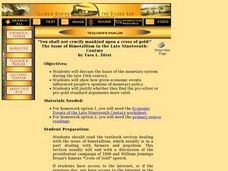Curated OER
Coming to America: U.S. Immigration
Analyze primary source documents relating the conditions under with prompted American immigration. Learners will analyze information in order to create a six-panel pamphlet. Much of the lesson is not available but the key objectives are....
Curated OER
African American Identity in the Gilded Age
Ninth graders examine the tension experienced by African-Americans as they struggled to establish a vibrant and meaningful identity based on the promises of liberty and equality in the midst of a society. In this American History...
Curated OER
Populists and Progressives
Students study the Gilded Age in American History. They present a speech demonstrating knowledge of the platforms of the Progressives and Populists.
PBS
Mark Twain: Storyteller, Novelist, and Humorist
Scholars investigate the use of satire in Mark Twain's writing. Literary lovers research the Adventures of Huckleberry Finn and Tom Sawyer, political cartoons, and videos to see how Twain uses satire to make the stories more memorable....
Stanford University
Pullman Strike
Learners explore the Pullman Strike. In this U.S. history lesson, students view a PowerPoint about the Pullman Strike of 1894. Learners discuss how this strike divided our nation. Students work with a group to analyze a newspaper...
Curated OER
Exploring US Foreign Policy after WWII--The Cold War
Scholars explore U.S. Foreign Policy and Cold War ideologies adopted after WWII. They conduct Internet research on a topic or issue related to the Cold War Era, watch two films, and compose a time line and a multimedia presentation to...
Curated OER
19th Century Immigration.
Eleventh graders analyze primary source cartoons depicting discrimination against immigrants. They study the historical relationship Dominican Republic has had with the United States. They assess how this relationship is linked to...
Curated OER
"you Shall Not Crucify Mankind Upon a Cross of Gold!": The Issue of Bimetallism in the Late Nineteenth-Century
Learners investigate the monetary system during the late 19th-century. They view a video, answer discussion questions, read and discuss text, and write an essay justifying either the pro-silver or pro-gold standard side.
Curated OER
"You shall not crucify mankind upon a cross of gold!" The Issue Bimetallism in the Late Nineteenth-Century
Young scholars research the basis of the monetary system suring the 19th century. They complete a worksheet and justify the pro-silver or the pro-gold argument.
Stanford University
Sheg: Document Based History: Reading Like a Historian: The Gilded Age
[Free Registration/Login Required] Students read primary source documents to solve a problem surrounding historical questions. The Gilded Age unit highlights the turbulent changes that characterized the end of the nineteenth century.
Stanford University
Sheg: Reading Like a Historian: 1898 North Carolina Election
[Free Registration/Login Required] Lesson using primary resources on the 1898 election in North Carolina during the Gilded Age. Includes handouts, primary sources, and student questions. Requires free registration to access resources.
Library of Congress
Loc: The Learning Page: American Indian Reservation Controversies
Primary sources help students understand issues and controversies surrounding the American Indian Reservations of the 1870s. Historians provide different accounts and views of this facet of American history, and students utilize these...
Library of Congress
Loc: Teachers: America at the Centennial
A lesson plan requiring student to analyze primary documents from the Philadelphia Centennial Exposition of 1876. Students interpret what these historical artifacts say "about the lives and values of Americans in 1876" among other things.














